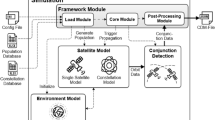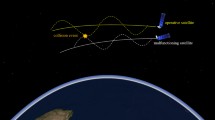Abstract
The satellite global positioning systems presently in space are the American NAVSTAR— GPS and the Russian GLONASS. Within this decade the European system, Galileo, should be operational in the same altitude range, dubbed MEO, Medium Earth Orbit. In this paper the fragmentation of a spacecraft related to one of these three constellations was simulated and the collision risk faced by the operational satellites was analyzed. Both the intra-constellation and the inter-constellation risk have been studied. An improvement in the collision risk calculation method developed in Valsecchi [5], is described in the paper. The new method overcomes the limitation in the application of Opik’s theory of planetary encounters, dictated by the assumption of random orientation of the argument of perigee of the projectiles, and allows its application to the Medium Earth orbital regime. In general terms it was observed in this study that the flux following a generic fragmentation is by far larger than the low background flux in MEO. The strong potential interaction of the three constellations has been shown by analyzing the inter-constellation effects of the fragmentations. In particular the GPS and the GLONASS strongly interact, while the Galileo constellation, orbiting at somewhat higher altitude, is less affected by any unfortunate event happening in the two lower constellations.
Similar content being viewed by others
References
KLINKRAD, H., BENDISH, J., BUNTE, K. D., KRAG, H., SDUNNUS, H., and WEGENER, P. “The MASTER-99 Space Debris and Meteoroid Environment Model,” Advances in Space Research, Vol. 28, 2001, pp. 1355–1366.
CHAO, C. C. and GICK, R. A. “Long-Term Evolution of Navigation Satellite Orbits: GPS/ GLONASS/GALILEO,” Advances in Space Research, Vol. 34, 2004, pp. 1221–1226.
JENKIN, A. B. and GICK, R. A. “Collision Risk Posed to the Global Positioning System by Disposal Orbit Instability,” Journal of Spacecraft and Rockets, Vol. 39, No. 4, 2002, pp. 532–539.
ÖPIK, E. J. Interplanetary Encounters, Elsevier, New York, USA, 1976.
VALSECCHI, G. B., ROSSI, A., and FARINELLA, P. “Visualizing Impact Probabilities of Space Debris,” Space Debris, Vol. 1, No. 2, 2000, pp. 143–158.
ROSSI, A., VALSECCHI, G. B., and FARINELLA, P. “Collision Risk for High Inclination Satellite Constellations,” Planetary and Space Science, Vol. 48, 2000, pp. 319–330.
DELL’ORO, A. and PAOLICCHI, P. “Statistical Properties of Encounters Among Asteroids: A New, General Purpose, Formalism,” Icarus, Vol. 136, 1998, pp. 328–339.
VALSECCHI, G. B., MILANI, A., GRONCHI, G. F., and CHESLEY, S. R. “Resonant Returns to Close Approaches: Analytical Theory,” Astronomy and Astrophysics, Vol. 408, 2003, pp. 1179–1196.
ROY, A. E. Orbital Motion, Adam Hilger Ltd., Bristol, UK, 1982.
ROSSI, A., VALSECCHI, G. B. and FARINELLA, P. “Risk of Collision for Constellation Satellites,” Nature, Vol. 399, 1999, pp. 743–744.
ROSSI, A. and VALSECCHI, G.B. “Self Generated Debris Hazard for Satellite Constellations,” Proceedings of the Second International Workshop on Satellite Constellations and Formation Flying, Haifa, Israel, Feb. 19–20, 2001, pp. 123–133.
ROSSI, A., ANSELMO, L., CORDELLI, A., FARINELLA, P., and PARDINI, C. “Modelling the Evolution of the Space Debris Population,” Planetary and Space Science, Vol. 46, 1998, pp. 1583–1596.
SU, S,-Y “The Velocity Distribution of the Collisional Fragments and its Effect on the Future Space Debris Environment,” Advances in Space Research, Vol. 10, 1990, pp. 389–392.
Author information
Authors and Affiliations
Rights and permissions
About this article
Cite this article
Rossi, A., Valsecchi, G.B. & Perozzi, E. Risk of Collision for the Navigation Constellations: The Case of the Forthcoming Galileo. J of Astronaut Sci 52, 455–474 (2004). https://doi.org/10.1007/BF03546412
Published:
Issue Date:
DOI: https://doi.org/10.1007/BF03546412




